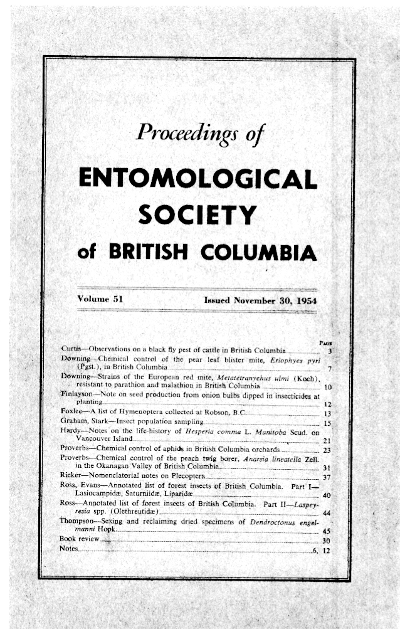Insect Population Sampling: General Considerations
Keywords:
SamplingAbstract
This paper has two sections: General Considerations – written by both authors; and Forest Defoliators – written by R.W. Stark. Each has its own references.References
General Considerations section
K. Graham and R.W. Stark, Department of Zoology, University of British Columbia, and the Forest Biology Division, Calgary. Alta.
Bliss, C.I., and R.A. Fisher. 1953. Fitting the negative binomial distribution to biological data and a note on the efficient fitting of the negative binomial. Biometrics 9: 176–199.
Eisenhart, Churchill. 1947. Assumptions underlying the analysis of variance. Biometrics 3(1).
Oakland. G.B. 1953. Determining sample size. Canadian Ent. 85: 108–113.
Quenouille, M.H. 1950. Introductory statistics. London, Butterworth-Springer Ltd.
Yates, F. 1949. Sampling methods for censuses and surveys. New York.
Forest Defoliators section
Butcher, J.W. 1951. The problem of sampling for forest insect populations. Proc. Ent. Soc. Manitoba 7: 30–34.
de Gryse, J.J. 1934. Quantitative methods in the study of forest insects. Sci. Agr. 14: 477–495.
Graham, K. 1952. A model problem in insect ecology. Proc. Ent. Soc. B.C. (1951) 48: 97–99.
Morris, R.F. 1949. Spruce budworm in Green River. Canada Dept. Agr., For. Biol. Div., Bi-monthly Prog. Rept. 5(4): I.
_______ 1950. Techniques for population sampling in standing trees. Canada Dept. Agr., For. Biol. Div., Bi-monthly Prog. Rept. 6(6): 1–2.
Prebble, M.L. 1943. Sampling methods in population studies of the European spruce sawfly, Gilpinia hercyniae (Hartig), in Eastern Canada. Trans. Royal Soc. of Canada, Ser. III, Sec. V, Vol. 37: 93–126.
Stark, R.W. 1952(a). Analysis of a population sampling method for the lodgepole needle miner in Canadian Rocky Mountain parks. Canadian Ent. 84: 316–321.
______ 1952(b). Sequential sampling of lodgepole needle miner. For. Chron. 28: 57–60.
Downloads
Published
Issue
Section
License
Authors who publish with the Journal of the Entomological Society of British Columbia agree to the following terms:
-Authors retain copyright and grant the journal right of first publication with the work simultaneously licensed under a Creative Commons Attribution License that allows others to share the work with an acknowledgement of the work's authorship and initial publication in this journal.
-Authors are able to enter into separate, additional contractual arrangements for the non-exclusive distribution of the journal's published version of the work (e.g., post it to an institutional repository or publish it in a book), with an acknowledgement of its initial publication in this journal.
-Authors are permitted and encouraged to post their work online (e.g., in institutional repositories or on their website) prior to and during the submission process, as it can lead to productive exchanges, as well as earlier and greater citation of published work (See The Effect of Open Access).


